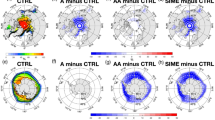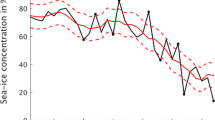Abstract
September sea ice concentration (SIC) is found to be most sensitive to the early melt onset over the East Siberian Sea and Laptev Sea (73°–84°N, 90°–155°) in the Arctic, a region defined here as the area of focus (AOF). The areal initial melt date for a given year is marked when sea ice melting extends beyond 10% of the AOF size. With this definition, four early melting years (1990, 2012, 2003, 1991) and four late melting years (1996, 1984, 1983, 1982) were selected. The impacts and feedbacks of atmospheric physical and dynamical variables on the Arctic SIC variations were investigated for the selected early and late melting years based on the NASA MERRA-2 reanalysis. The sea ice melting tends to happen in a shorter period of time with larger magnitude in late melting years, while the melting lasts longer and tends to be more temporally smooth in early melting years. The first major melting event in each year has been further investigated and compared. In the early melting years, the positive Arctic Oscillation (AO) phase is dominant during springtime, which is accompanied by intensified atmospheric transient eddy activities in the Arctic and enhanced moisture flux convergence in the AOF and consequently enhanced northward transport of moist and warm air. As a result, positive anomalies of air temperature, precipitable water vapor (PWV) and/or cloud fraction and cloud water path were found over the AOF, increasing downward longwave radiative flux at the surface. The associated warming effect further contributes to the initial melt of sea ice. In contrast, the late melt onset is usually linked to the negative AO phase in spring accompanied with negative anomalies of PWV and downward longwave flux at the surface. The increased downward shortwave radiation during middle to late June plays a more important role in triggering the melting, aided further by the stronger than normal cloud warming effects.










Similar content being viewed by others
References
Bacmeister JT, Suarez MJ, Robertson FR (2006) Rain reevaporation, boundary layer-convection interactions, and Pacific rainfall patterns in an AGCM. J Atmos Sci 63:3383–3403
Baggett C, Lee S, Feldstein S (2016) An investigation of the presence of atmospheric rivers over the North Pacific during planetary-scale wave life cycles and their role in Arctic warming. J Atmos Sci 73(11):4329–4347
Banacos PC, Schultz DM (2005) The use of moisture flux convergence in forecasting convective initiation: historical and operational perspectives. Weather Forecast 20(3):351–366
Barber DG, Thomas A (1998) The influence of cloud cover on the radiation budget, physical properties, and microwave scattering coefficient of first-year and multiyear sea ice. IEEE Trans Geosci Remote Sens 36(1):38–50
Belchansky GI, Douglas DC, Platonov NG (2004) Duration of the Arctic sea ice melt season: regional and interannual variability, 1979–2001. J Clim 17(1):67–80
Blackmon ML (1976) A climatological spectral study of the 500 mb geopotential height of the Northern Hemisphere. J Atmos Sci 33(8):1607–1623
Blackmon ML, Wallace JM, Lau NC, Mullen SL (1977) An observational study of the Northern Hemisphere wintertime circulation. J Atmos Sci 34(7):1040–1053
Bosilovich M et al (2015) MERRA-2: initial evaluation of climate. Technical Report Series Technical Report Series on Global Modeling and Data Assimilation, vol 43. http://gmao.gsfc.nasa.gov/pubs/tm/docs/Bosilovich803.pdf
Cavalieri DJ, Parkinson CL, Gloersen P, Zwally HJ (1996) Sea ice concentrations from nimbus-7 SMMR and DMSP SSM/I-SSMIS passive microwave data, version 1. NASA National snow and ice data center distributed active archive center. Digital data, Boulder, Colorado USA. https://doi.org/10.5067/8GQ8LZQVL0VL. (Date Accessed)
Chou MD, Suarez MJ (1999) A solar radiation parameterization for atmospheric studies. NASA Tech Memo 104606:40
Chou MD, Suarez MJ, Liang Z, Yan MMH (2001) A thermal infrared radiation parameterization for atmospheric studies. NASA Technical report series on global modeling and data assimilation, NASA/TM- 2001-104606, vol 19
Curry JA, Schramm JL, Ebert EE (1995) Sea ice-albedo climate feedback mechanism. J Clim 8(2):240–247
Deser C, Walsh JE, Timlin MS (2000) Arctic sea ice variability in the context of recent tmospheric circulation trends. J Clim 13(3):617–633
Dong X, Zib BJ, Xi B, Stanfield R, Deng Y, Zhang X, Lin B, Long CN (2014) Critical mechanisms for the formation of extreme arctic sea-ice extent in the summers of 2007 and 1996. Clim Dyn 43(1–2):53–70
Donlon C et al (2012) The Global Monitoring for Environment and Security (GMES) Sentinel-3 mission. Remote Sens Environ 120:37–57
Drobot SD, Anderson MR (2001) Comparison of interannual snowmelt-onset dates with atmospheric conditions. Ann Glaciol 33(1):79–84
Gelaro R, Coauthors (2017) The modern-era retrospective analysis for research and applications, version 2 (MERRA-2). J Clim 30(14): 5419–5454
Hegyi BM, Deng Y (2017) Dynamical and thermodynamical impacts of high-and low-frequency atmospheric eddies on the initial melt of Arctic sea ice. J Clim 30(3):865–883
Huang Y, Dong X, Xi B, Dolinar EK, Stanfield RE (2017a) The footprints of 16 year trends of Arctic springtime cloud and radiation properties on September sea ice retreat. J Geophys Res Atmos 122(4):2179–2193
Huang Y, Dong X, Xi B, Dolinar EK, Stanfield RE, Qiu S (2017b) Quantifying the uncertainties of reanalyzed arctic cloud and radiation properties using satellite surface observations. J Clim 30(19):8007–8029
Lin SJ (2004) A “vertically Lagrangian” finite-volume dynamical core for global models. Mon Weather Rev 132(10):2293–2307
Maksimovich E, Vihma T (2012) The effect of surface heat fluxes on interannual variability in the spring onset of snow melt in the central Arctic Ocean. J Geophys Res Oceans. https://doi.org/10.1029/2011JC007220
Markus T, Stroeve JC, Miller J (2009) Recent changes in Arctic sea ice melt onset, freezeup, and melt season length. J Geophys Res Oceans. https://doi.org/10.1029/2009JC005436
Maslanik JA, Serreze MC, Barry RG (1996) Recent decreases in Arctic summer ice cover and linkages to atmospheric circulation anomalies. Geophys Res Lett 23(13):1677–1680
Maslanik JA, Fowler C, Stroeve J, Drobot S, Zwally J, Yi D, Emery W (2007) A younger, thinner Arctic ice cover: increased potential for rapid, extensive sea-ice loss. Geophys Res Lett 34(24)
Mortin J, Howell SE, Wang L, Derksen C, Svensson G, Graversen RG, Schrøder TM (2014) Extending the QuikSCAT record of seasonal melt–freeze transitions over Arctic sea ice using ASCAT. Remote Sens Environ 141:214–230
Mortin J, Svensson G, Graversen RG, Kapsch ML, Stroeve JC, Boisvert LN (2016) Melt onset over Arctic sea ice controlled by atmospheric moisture transport. Geophys Res Lett 43(12):6636–6642
Perovich DK, Polashenski C (2012) Albedo evolution of seasonal Arctic sea ice. Geophys Res Lett 39(8)
Persson POG (2012) Onset and end of the summer melt season over sea ice: thermal structure and surface energy perspective from SHEBA. Clim Dyn 39(6):1349–1371
Qiu S, Dong X, Xi B, Li J (2015) Characterizing Arctic mixed-phase cloud structure and its relationship with humidity and temperature inversion using ARM NSA observations. J Geophys Res Atmos 120:7737–7746. https://doi.org/10.1002/2014JD023022
Qiu S, Xi B, Dong X (2018) Influence of wind direction on thermodynamic properties and Arctic mixed-phase clouds in autumn at Utqiaġvik, Alaska. J Geophys Res Atmos. https://doi.org/10.1029/2018JD028631
Reynolds RW, Smith TM, Liu C, Chelton DB, Casey KS, Schlax MG (2007) Daily high-resolution-blended analyses for sea surface temperature. J Clim 20:5473–5496. https://doi.org/10.1175/2007JCLI1824.1
Rienecker MM, Coauthors (2011) MERRA: NASA’s modern-era retrospective analysis for research and applications. J Clim 24: 3624–3648. https://doi.org/10.1175/JCLI-D-11-00015.1
Rigor IG, Colony RL, Martin S (2000) Variations in surface air temperature observations in the Arctic, 1979–97. J Clim 13(5):896–914
Rigor IG, Wallace JM, Colony RL (2002) Response of sea ice to the Arctic Oscillation. J Clim 15(18):2648–2663
Serreze MC, Maslanik JA, Key JR, Kokaly RF, Robinson DA (1995) Diagnosis of the record minimum in Arctic sea ice area during 1990 and associated snow cover extremes. Geophys Res Lett 22(16):2183–2186
Stroeve JC, Markus T, Boisvert L, Miller J, Barrett A (2014) Changes in Arctic melt season and implications for sea ice loss. Geophys Res Lett 41(4):1216–1225
Taylor KE, Williamson D, Zwiers F (2000) The sea surface temperature and sea ice concentration boundary conditions for AMIP II simulations. Program for Climate Model Diagnosis and Intercomparison (PCMDI). Report 60, Lawrence Livermore National Laboratory
Thompson DW, Wallace JM (1998) The Arctic Oscillation signature in the wintertime geopotential height and temperature fields. Geophys Res lett 25(9):1297–1300
Villamil-Otero GA, Zhang J, He J, Zhang X (2017) Role of extratropical cyclones in the recently observed increase in Poleward moisture transport into the Arctic Ocean. Adv Atmos Sci. https://doi.org/10.1007/s00376-017-7116-0
Walsh JE, Chapman WL, Shy TL (1996) Recent decrease of sea level pressure in the central Arctic. J Clim 9(2):480–486
Wei L, Qin T, Li C (2017) Seasonal and inter-annual variations of Arctic cyclones and their linkage with Arctic sea ice and atmospheric teleconnections. Acta Oceanol Sin 36(10):1–7
Wettstein JJ (2007) Storm track variability and interaction with the background flow on daily, interannual and climate change time scales. University of Washington, Seattle
Zhang J, Rothrock D, Steele M (2000) Recent changes in Arctic sea ice: the interplay between ice dynamics and thermodynamics. J Clim 13(17):3099–3114
Acknowledgements
This study was supported by NASA CERES project under Grant NNX17AC52G at the University of Arizona. Yi Deng is partly supported by the National Science Foundation Climate and Large-Scale Dynamics (CLD) program through grants AGS-1354402 and AGS-1445956. Sea Ice Concentrations from Nimbus-7 SMMR and DMSP SSM/I-SSMIS Passive Microwave Data, Version 1 is accessed from NASA DAAC at the National Snow and Ice Data Center at http://nsidc.org/data/docs/daac/nsidc0051_gsfc_seaice.gd.html#cavalieri_92. The Arctic sea ice melt data used comes from NASA Cryosphere Science Research Portal (https://neptune.gsfc.nasa.gov/csb/index.php?section=54). MERRA-2 reanalysis provides atmospheric properties in this study, which can be obtained from NASA Goddard Earth Sciences Data and Information Services Center (https://disc.sci.gsfc.nasa.gov/datasets?page=1&keywords=MERRA-2). In addition, Arctic Oscillation (AO) index is obtained from NOAA National Centers for Environmental Information webpage (https://www.ncdc.noaa.gov/teleconnections/ao/). We would like to thank Thomas Galarneau for discussion and Timothy Logan for proofreading. Also, we appreciate two anonymous reviewers for their constructive comments and suggestions.
Author information
Authors and Affiliations
Corresponding author
Electronic supplementary material
Below is the link to the electronic supplementary material.
Rights and permissions
About this article
Cite this article
Huang, Y., Dong, X., Xi, B. et al. A survey of the atmospheric physical processes key to the onset of Arctic sea ice melt in spring. Clim Dyn 52, 4907–4922 (2019). https://doi.org/10.1007/s00382-018-4422-x
Received:
Accepted:
Published:
Issue Date:
DOI: https://doi.org/10.1007/s00382-018-4422-x




